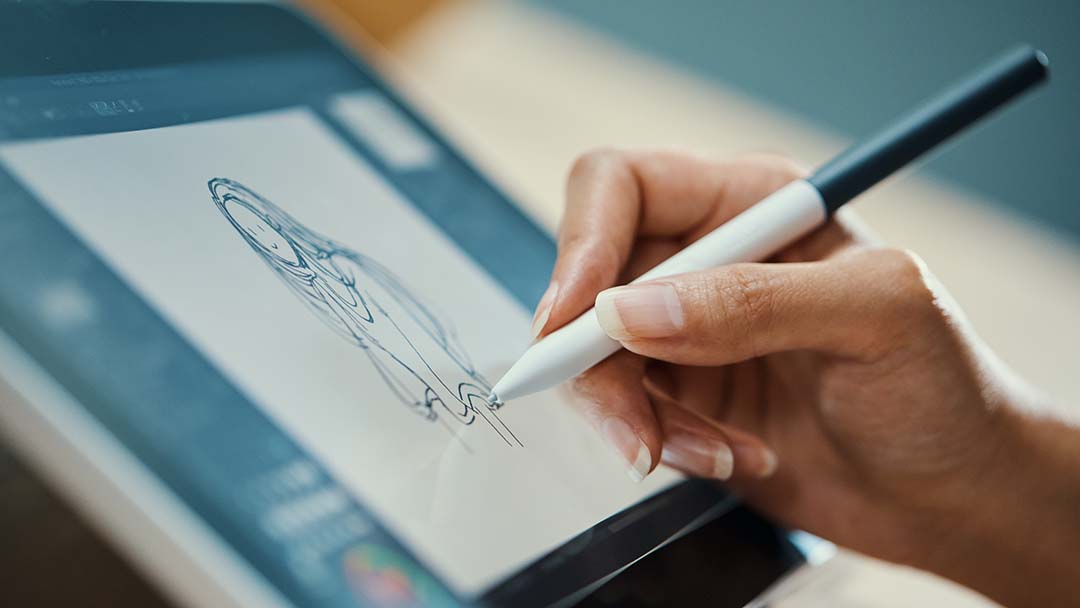In the world of digital arts and creative professions, certain tools have emerged as game-changers, enabling professionals to push boundaries and redefine possibilities. This is where Wacom comes in. Whether it’s a digital art conservator meticulously preserving the past, a UX designer crafting seamless user experiences, a 3D sculptor designing models for the latest blockbuster video game, a VR artist painting immersive worlds, or a generative artist melding code and creativity, one common thread unites these diverse careers: the essential role of technology.
In this blog post, we’ll explore how these specialized tools, such as Wacom pen displays and pen tablets, have become indispensable assets for a variety of creative careers, providing precision, control, and creative freedom to excel in the world of digital arts. Read on for a journey through these specialized creative professions and discover how advanced digital tools like Wacom pen technologies empower visionaries to redefine what’s possible.

Digital art conservators and restorers: Precision and fidelity
Digital art conservators and restorers play a pivotal role in digitally preserving artistic masterpieces for future generations. Their work requires a delicate touch and precise attention to detail. With tools like Wacom pen tablets and displays, which offer unmatched precision, conservators and restorers can digitally protect and restore artwork with fidelity and accuracy. Every brushstroke or correction becomes an act of preservation, made possible by these advanced tools.
Education:
Digital art conservators typically hold a bachelor’s degree in art conservation, art history, or a related field, but experience and training in digital art practice can also be essential. Advanced positions may require a master’s degree in art conservation.
Skills:
- Proficiency in digital art restoration techniques
- Strong attention to detail and a delicate touch
- In-depth knowledge of art history and digital preservation

3D printing specialists: Crafting tangible dreams
3D printing specialists transform digital models into tangible creations, bringing dreams to life in three dimensions. The precision required in their work is complemented by technology designed specifically for their needs. These specialists use advanced digital tools to sculpt, refine, and prepare their models for printing. Responsive digital pens, like Wacom’s, offer a level of control that’s essential for translating digital concepts into physical reality.
Education:
Aspiring 3D printing specialists may pursue a bachelor’s degree in engineering, industrial design, or a related field. Hands-on training and certifications in 3D printing technologies are also valuable.
Skills:
- Proficiency in 3D modeling software and 3D printing technology
- Attention to detail and precision in model preparation
- Understanding of materials used in 3D printing

Virtual Reality (VR) artists: Creating immersive worlds
VR artists craft immersive experiences in virtual reality, transporting users to entirely new realms. Their canvas is a digital landscape, and their palette is an intricate blend of colors, shapes, and emotions. With advanced technology at their disposal, VR artists have the tools they need to create these immersive worlds with extraordinary precision. The result is a deeply immersive and emotionally resonant experience for users.
Education:
VR artists often begin with a degree in digital arts, computer graphics, or a related field. Some are self-taught and build portfolios through personal projects.
Skills:
- Proficiency in VR software and 3D modeling
- Strong creative and artistic abilities
- Understanding of immersive storytelling and user experience design

Generative artists: Melding code and creativity
Generative artists create art through code and algorithms, forging a unique fusion of human vision and computational precision. For these artists, advanced digital tools serve as a bridge between the digital and the artistic. The ability to sketch, draw, and manipulate code with the same fluidity as traditional media empowers generative artists to express their creativity more authentically. These specialized tools ensure that their creations retain the human touch.
Education:
Generative artists may come from diverse educational backgrounds, including computer science, mathematics, or creative coding. However, formal education is not always a prerequisite.
Skills:
- Proficiency in programming languages such as Processing or Python.
- Artistic vision to blend code with creative expression.
- Ability to manipulate digital media seamlessly.

Other creative careers that use modern digital tools
There are many other career options in the digital arts:
- Digital fabrication artist: Digital fabrication artists use computer-controlled machines like CNC routers and laser cutters to create intricate physical objects and sculptures. They combine design skills with knowledge of digital fabrication technologies.
- Forensic animator: Forensic animators use computer graphics and animation software to recreate crime scenes or accidents. They can create 3D reconstructions of crime scenes, accidents, or events to help investigators and jurors better understand the sequence of events.
- Augmented Reality (AR) designer: AR designers specialize in creating digital overlays and experiences that blend the virtual and physical worlds. They work on AR apps, games, and interactive installations.
- Sound designer for interactive media: These professionals focus on creating audio experiences for video games, virtual reality, and interactive media. They design sound effects, music, and voiceovers to enhance the user’s experience.
- Virtual set designer: Virtual set designers create digital environments used in television and film production. They use 3D modeling and compositing techniques to design sets that seamlessly integrate with live action.
- Digital marketing artist: Digital marketing artists create visual content and assets for digital marketing campaigns. They design eye-catching banners, infographics, and social media graphics to promote products and brands online.
- Forensic Digital Sculptor: Digital sculptors create 3D reconstructions of human faces or remains based on skeletal remains or partial remains. This can aid in the identification of unidentified bodies.
- Medical illustrator: Medical illustrators use their artistic skills and digital tools to create detailed and accurate illustrations of anatomical structures, medical procedures, and scientific concepts. Their work is used in medical education and publications.
These careers highlight the diverse applications of digital arts across various industries, including healthcare, forensics, entertainment to marketing and education. Each role requires a unique set of skills and expertise, making them exciting options for those interested in combining creativity with technology.

Advanced digital tools have emerged as indispensable assets for individuals in every creative career, providing them with the precision, control, and creative freedom needed to excel in their respective fields. Whether they’re preserving digital masterpieces, harmonizing content and design, crafting tangible dreams, painting immersive worlds, or melding code and creativity, these tools empower creative visionaries to push boundaries and explore uncharted horizons.
As the digital arts landscape continues to evolve, these specialized technologies, like those from Wacom, remain steadfast allies, enabling professionals to redefine what’s possible.





